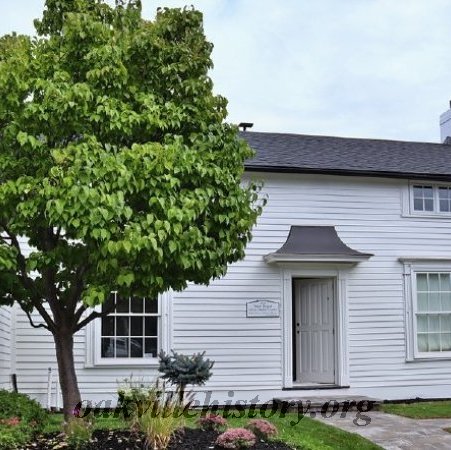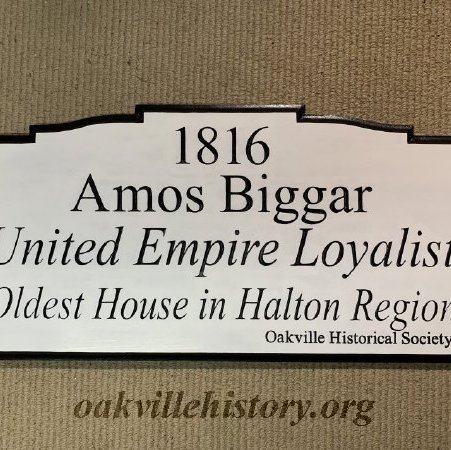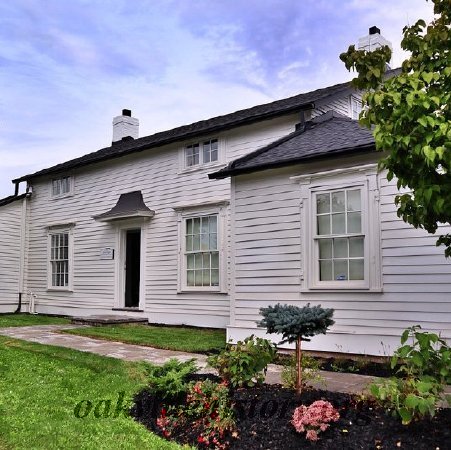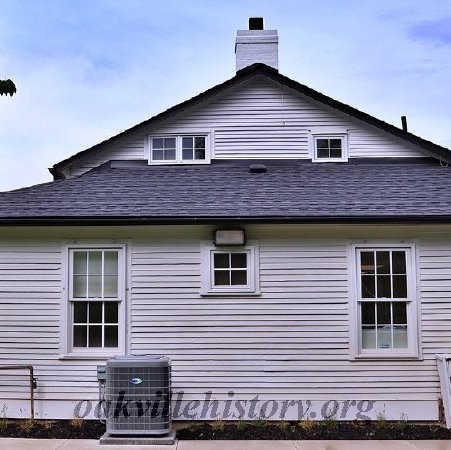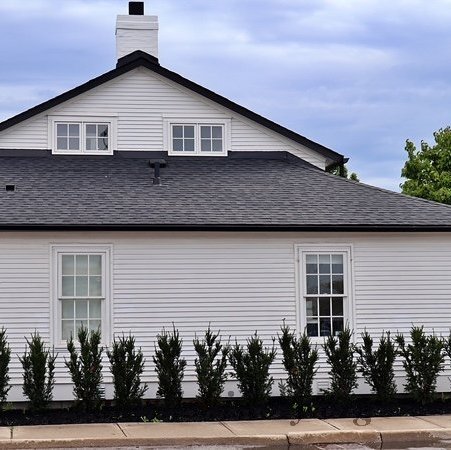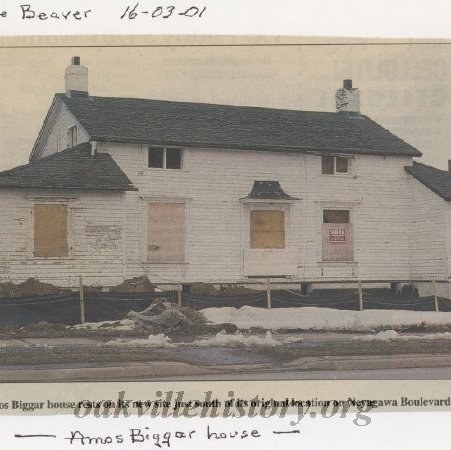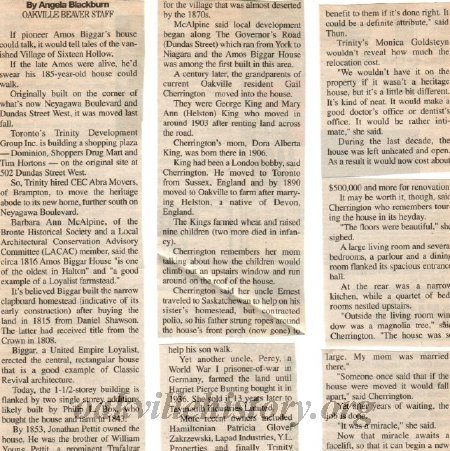Address:
2441 Neyagawa - The home of Amos Biggar and Margaret Pettit
Summary:
Dundas Street, initially named 'The Governor's Road,' was envisioned by Lieutenant Governor John Graves Simcoe in 1793 to safeguard against potential southern invasions. It now stands as a preserved landmark.
Property Details:
Dundas Street, originally known as 'The Governor's Road', was the inland route proposed by Lieutenant Governor John Graves Simcoe in 1793, for military purposes. It was intended to provide the safe transport of supplies and troops as a protection against a possible invasion from the south. The road was little more than a trail and needed constant maintenance.
To encourage new settlement and to maintain the road, the Crown acquired a tract of land from the Mississauga First Nation in 1806. Deputy Provincial Surveyor Samuel Wilmot surveyed the area into three townships, one of which was Trafalgar Township. Using Dundas Street as a baseline, the land was divided into concessions one and a quarter miles apart and into 200-acre lots, with a regulation sixty-six-foot-wide roadway. Settlers were obliged to clear five acres, fence in their lots, and build a house, usually a log cabin made of the trees that were cut down. If the lot bordered the road, trees had to be cleared within one hundred feet of the road, and landowners were responsible for making improvements to the road.
The 1806 Wilmot Survey shows the early settlers who signed a Condition of Settlement. Daniel Shannon signed for Lot 20, 1st Concession, South of Dundas Street. Acquisition of the lot was completed in 1808, presumably on meeting all of the conditions. At this time, there were a total of thirty-three landowners.
In 1815 the property was sold to Amos Biggar, whose family were United Empire Loyalists. His father, John Biggar and mother Jemima Pettit, moved from Bethlehem, New Jersey to Upper Canada and settled in Saltfleet Township in 1791. John was active in local affairs and like other Loyalists, he and his sons served in the War of 1812 with the West Lincoln Regiment. Amos is listed on the roll of the 5th Lincoln Militia when it was first established. In April 1816, Justice of the Peace, Robert Nelles, married him to Margaret Pettit.
It is believed that he built the central portion of the house at 502 Dundas Street West. The house is considered to be a fine example of a Loyalist farmstead. The original section is a one and a half storey and features narrow weatherboard siding, multi-paned windows and a classically inspired doorway. The house was enlarged with additions to both sides of the house, possibly made by the next owner, Phillip L. Box who purchased the farm in 1843.
Charles and James, Amos Biggar's two brothers, also owned nearby lots in the township. In the 1817 statistical survey by Robert Gourlay, the three brothers were among landowners who responded to the survey. As an indication of the growth of the area, they reported that the population totaled 548 and that there were 97 houses, 3 schools, 4 taverns, 1 grist mill and 4 saw mills. There were no stores or medical practitioners or churches. They were very candid in their appraisal of what improvements were needed which alarmed government authorities. Robert Gourlay was arrested and the survey was suppressed until 1822.
By the 1820s, Dundas Street was the main east west route between Toronto and Dundas. Traffic had increased considerably and there were links to the lake ports to expedite the export of farmers' produce. By this time there was a regular stagecoach service providing mail delivery and, the opening of many taverns and inns to accommodate travelers.
Amos Biggar was included in the first census in Ontario in 1841, taken at a time when Upper Canada became Canada West. He is listed as a "farmer, proprietor of Lot 20, 1st Concession, S.D.S., self, wife and eight children born in Canada".
The house and the area had two associations with the Rebellion of 1837 and is one of the few homes that remain in Trafalgar Township from that period. After the failure of the uprising at Montgomery's Tavern in Toronto, William Lyon Mackenzie used Dundas Street as his escape route to Niagara. He would have passed directly by the house. There are several colourful accounts of his travel through Trafalgar Township, but it is believed that he stayed in the nearby village of "Sixteen Hollow" before continuing his flight and may have hid out at a neighbouring farm.
William Young Pettit, who owned the neighbouring farm and would purchase the Biggar house in 1853, was the brother of Jonathan Smith Pettit, also of United Empire Loyalist heritage. Following the Rebellion, as a prominent Tory, William chaired a meeting of local farmers gathered to protest a bill to compensate losses in Lower Canada. With Loyalist sympathies, they were outraged at the prospect of people being compensated who may have participated in the Rebellion against the Crown. The unruly meeting was reported in the press.
In 1903, George King, an area farmer who lived on the north side of Dundas Street, purchased the property. He was British born and immigrated to Canada with his family when he was 18. He moved with his wife from Toronto to Trafalgar Township around 1890. They had nine children, all of whom lived on the farm at one time. The King family sold the farm to Harriet Pierce Bunting in 1936, who sold the property in 1949 to Taymouth Industries Limited.
In 1995, the house was designated by the Town of Oakville as a 'property of historical, architectural and contextual value and interest' under the Ontario Heritage Act. For some time after 1996, the house stood vacant and was subjected to vandalism and vagrants living in the house. Gail Cherrington, a granddaughter of George King, kept a close eye on the house and advised the Town as problems occurred. Without this monitoring, the house may have been lost.
The land was purchased for a shopping mall by a development company which was required by the Town to move the house to a nearby location and to board up the windows and doors. In 2000, the house was moved from its original location to 2441 Neyagawa Blvd. The house was acquired by Jelinek Cork Group which restored the building with great care to preserve the spirit of the house. This is a wonderful example of how history can combine with commerce in the interests of the community. 'The Cork House' as it became known, was used as a product showroom.
In September 2006, Jelinek Cork Group had a public unveiling of the historical plaques provided by the Oakville Historical Society. Invited guests included the Mayor of Oakville, friends, and members of the King family and others who had connections to the house. The Jelinek Cork Group are to be congratulated for their dedication in the restoration of this heritage building which is believed to be the oldest house in Halton.
It was recently renovated again and is now the office of dentist Dr Danny Soares.
To encourage new settlement and to maintain the road, the Crown acquired a tract of land from the Mississauga First Nation in 1806. Deputy Provincial Surveyor Samuel Wilmot surveyed the area into three townships, one of which was Trafalgar Township. Using Dundas Street as a baseline, the land was divided into concessions one and a quarter miles apart and into 200-acre lots, with a regulation sixty-six-foot-wide roadway. Settlers were obliged to clear five acres, fence in their lots, and build a house, usually a log cabin made of the trees that were cut down. If the lot bordered the road, trees had to be cleared within one hundred feet of the road, and landowners were responsible for making improvements to the road.
The 1806 Wilmot Survey shows the early settlers who signed a Condition of Settlement. Daniel Shannon signed for Lot 20, 1st Concession, South of Dundas Street. Acquisition of the lot was completed in 1808, presumably on meeting all of the conditions. At this time, there were a total of thirty-three landowners.
In 1815 the property was sold to Amos Biggar, whose family were United Empire Loyalists. His father, John Biggar and mother Jemima Pettit, moved from Bethlehem, New Jersey to Upper Canada and settled in Saltfleet Township in 1791. John was active in local affairs and like other Loyalists, he and his sons served in the War of 1812 with the West Lincoln Regiment. Amos is listed on the roll of the 5th Lincoln Militia when it was first established. In April 1816, Justice of the Peace, Robert Nelles, married him to Margaret Pettit.
It is believed that he built the central portion of the house at 502 Dundas Street West. The house is considered to be a fine example of a Loyalist farmstead. The original section is a one and a half storey and features narrow weatherboard siding, multi-paned windows and a classically inspired doorway. The house was enlarged with additions to both sides of the house, possibly made by the next owner, Phillip L. Box who purchased the farm in 1843.
Charles and James, Amos Biggar's two brothers, also owned nearby lots in the township. In the 1817 statistical survey by Robert Gourlay, the three brothers were among landowners who responded to the survey. As an indication of the growth of the area, they reported that the population totaled 548 and that there were 97 houses, 3 schools, 4 taverns, 1 grist mill and 4 saw mills. There were no stores or medical practitioners or churches. They were very candid in their appraisal of what improvements were needed which alarmed government authorities. Robert Gourlay was arrested and the survey was suppressed until 1822.
By the 1820s, Dundas Street was the main east west route between Toronto and Dundas. Traffic had increased considerably and there were links to the lake ports to expedite the export of farmers' produce. By this time there was a regular stagecoach service providing mail delivery and, the opening of many taverns and inns to accommodate travelers.
Amos Biggar was included in the first census in Ontario in 1841, taken at a time when Upper Canada became Canada West. He is listed as a "farmer, proprietor of Lot 20, 1st Concession, S.D.S., self, wife and eight children born in Canada".
The house and the area had two associations with the Rebellion of 1837 and is one of the few homes that remain in Trafalgar Township from that period. After the failure of the uprising at Montgomery's Tavern in Toronto, William Lyon Mackenzie used Dundas Street as his escape route to Niagara. He would have passed directly by the house. There are several colourful accounts of his travel through Trafalgar Township, but it is believed that he stayed in the nearby village of "Sixteen Hollow" before continuing his flight and may have hid out at a neighbouring farm.
William Young Pettit, who owned the neighbouring farm and would purchase the Biggar house in 1853, was the brother of Jonathan Smith Pettit, also of United Empire Loyalist heritage. Following the Rebellion, as a prominent Tory, William chaired a meeting of local farmers gathered to protest a bill to compensate losses in Lower Canada. With Loyalist sympathies, they were outraged at the prospect of people being compensated who may have participated in the Rebellion against the Crown. The unruly meeting was reported in the press.
In 1903, George King, an area farmer who lived on the north side of Dundas Street, purchased the property. He was British born and immigrated to Canada with his family when he was 18. He moved with his wife from Toronto to Trafalgar Township around 1890. They had nine children, all of whom lived on the farm at one time. The King family sold the farm to Harriet Pierce Bunting in 1936, who sold the property in 1949 to Taymouth Industries Limited.
In 1995, the house was designated by the Town of Oakville as a 'property of historical, architectural and contextual value and interest' under the Ontario Heritage Act. For some time after 1996, the house stood vacant and was subjected to vandalism and vagrants living in the house. Gail Cherrington, a granddaughter of George King, kept a close eye on the house and advised the Town as problems occurred. Without this monitoring, the house may have been lost.
The land was purchased for a shopping mall by a development company which was required by the Town to move the house to a nearby location and to board up the windows and doors. In 2000, the house was moved from its original location to 2441 Neyagawa Blvd. The house was acquired by Jelinek Cork Group which restored the building with great care to preserve the spirit of the house. This is a wonderful example of how history can combine with commerce in the interests of the community. 'The Cork House' as it became known, was used as a product showroom.
In September 2006, Jelinek Cork Group had a public unveiling of the historical plaques provided by the Oakville Historical Society. Invited guests included the Mayor of Oakville, friends, and members of the King family and others who had connections to the house. The Jelinek Cork Group are to be congratulated for their dedication in the restoration of this heritage building which is believed to be the oldest house in Halton.
It was recently renovated again and is now the office of dentist Dr Danny Soares.
